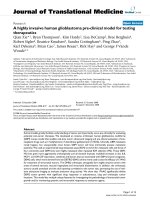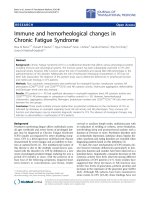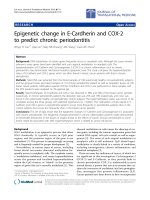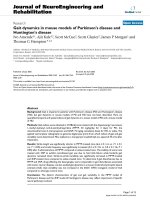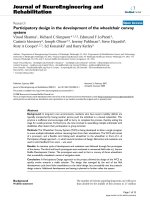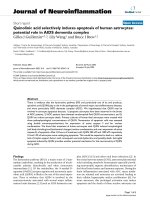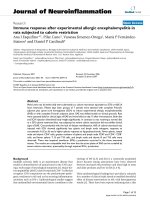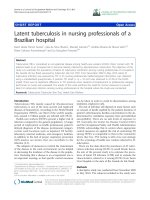Báo cáo hóa học: "Immune signatures in human PBMCs of idiotypic vaccine for HCV-related lymphoproliferative disorders" pptx
Bạn đang xem bản rút gọn của tài liệu. Xem và tải ngay bản đầy đủ của tài liệu tại đây (1.54 MB, 11 trang )
RESEARC H Open Access
Immune signatures in human PBMCs of idiotypic
vaccine for HCV-related lymphoproliferative
disorders
Luigi Buonaguro
1,9
, Annacarmen Petrizzo
1
, Marialina Tornesello
1
, Maria Napolitano
2
, Debora Martorelli
3
,
Giuseppe Castello
2
, Gerardo Beneduce
4
, Amalia De Renzo
5
, Oreste Perrella
6
, Luca Romagnoli
7
, Vitor Sousa
7
,
Valli De Re
8
, Riccardo Dolcetti
3
, Franco M Buonaguro
1*
Abstract
Hepatitis C virus (HCV) is one of the major risk factors for chronic hepatitis, which may progress to cirrhosis and
hepatocellular carcinoma, as well as for type II mixed cryoglobulinemia (MC), which may further evolve into an
overt B-cell non-Hodgkin’s lymphoma (NHL).
It has been previously shown that B-cell receptor (BCR) repertoire, expressed by clonal B-cells involved in type II
MC as well as in HCV-associated NHL, is constrained to a limite d number of variable heavy (VH)- and light (VL)-
chain genes. Among these, the VK3-20 light chain idiotype has been selected as a possible target for passive as
well as active immunization strategy.
In the present study, we describe the results of a multiparametric analysis of the innate and early adaptive immune
response after ex vivo stimulation of human immune cells with the VK3-20 protein. This objective has been pur-
sued by implementing high-throughput technologies such as multiparameter flow cytometry and multiplex analy-
sis of cytokines and chemokines.
Introduction
Hepatitis C virus (HCV) is a Hepacivirus of the Flaviviri-
dae family, mainly involved in hepatic disorders, includ-
ing chron ic hepatitis which may progress to cirrhosis in
about 10-20% of cases and further to hepatocellular car-
cinoma in 1-5% of cirrhotic patients [1].
Subsequently, the virus has been implicated as one of
the major risk factors for type II mixed cryoglobuline-
mia (MC), an autoimmune disease that may evo lve into
an overt B-cell non-Hodgkin’ slymphoma(NHL)in
about 10% of MC patients [2-5]. Several s tudies have
contributed to establish the causative role of HCV infec-
tion in the etiopathogenesis of MC, showing the
presence of the viral RNA and/or anti-HCV antibodies
in a range of 70 to 100% of M C [6-8]. Furthermore, the
clinical evolution of MC is closely linked to the natural
history of the underlying HCV chronic infection [9,10].
The most accredited pathogenetic mechanism of MC
during HCV chronic infection is the persistent immune
stimulation sustained by viral proteins which, i n turn,
may result in production of cross-reactive autoantibo-
dies, including cryoglobulins [11,12]. Chronic stimula-
tion of the B-cell by HCV epitopes may produce the
expansion of B-cell subpopulations with dominant
genetic characteristics. In particular, the interaction
between HCV E2 protein and CD81 molecule, an almost
ubiquitous tetraspannin present on B-cell surface, has
been shown and it may lead to a strong and sustained
polyclonal stimulation of B -cell compartment [13].
Furthermore, the t (14,18) translocation observed in
85% of the patients affected by HCV-related type II MC
might lead to abnormally elevated expression of Bcl-2
protein with consequent inhibition of apoptosis and
increased B-cell survival [14]. This multistep process
may ultimately lead to B-cell NHL as late complication
of the MC syndrome [9,15].
The clonality of expanded B cells can be defined by
the analysis of the antigen-binding region (so called
* Correspondence:
1
Lab. of Molecular Biology and Viral Oncogenesis & AIDS Reference Center,
Istituto Nazionale Tumori “Fond. G. Pascale”, Naples, Italy
Buonaguro et al. Journal of Translational Medicine 2010, 8:18
/>© 2010 Buonaguro et al; licensee BioMed Central Ltd. This is an Open Access article distributed under the terms of the Creative
Commons Attribution License (http:/ /creativecommons.org/licenses/by/2.0), which permits unrestricted use, distribution, and
reproduction in any medium, provided the original work is proper ly cited.
idiotype, Id) of the immunoglobulin produced and
expressed by the B-cell clone. According to the variety
of Ids identified, the lymphopro liferative disorder may
be sustained by mono-, oligo- or polyclonal B cells. It
has been previously demonstrated that the B-cell recep-
tor (BCR) repertoire expressed by clonal B-cells involved
in HCV-asso ciated type II MC as we ll as in NHL is not
random, with V1-69, V3-7, V4- 59 variabl e heav y (VH) -
and still more variable (VK)3-20 and VK3-15 light
(VL)-chain genes being the most represented [16-18].
These data suggest a model of antigen-driven origin for
these lymphoproliferative disorders with the recognition
of a limited number of HCV antigens [18,19].
The constrained heterogeneity of Ids shared by such
patients strongly suggests the possibility of targeting one
or few idiotypes to hit and eliminate the B cell clone
sustaining the HCV-associated NHL. One strategy is to
generate idiotype-specific MAbs to be employed in a
selective passive immunization [20]. An alternative strat-
egy is to use an idiotype vaccine [21] in order to elicit
an active humoral/cellular immune response as preven-
tive and/or therapeutic approach against the expansion
of the B cell clone sustaining the HCV-associated NHL.
We have previously shown that a multivariate and
multiparametric analysis can predict the innate and
early adaptive immune response induced by a vaccine
molecule in human monocyte-derived dendritic cells
(MDDCs) as well as whole peripheral blood mononuc-
lear cells (PBMCs) using an ex-vivo experimental
setting. This systems biology approach involves high-
throughput technologies such as global gene expression
profiling, multiplex analysis of cytokines and chemo-
kines, and multiparameter flow cytometry, combined
with computational modeling [22-26].
In the present study, we performed a multiparametric
analysis of the innate and early adaptive immune
response after ex vivo stimulation with the VK3-20 light
chain protein, the idiotype most freque ntly identified on
B cell clones sustain ing the HCV-associ ated type II MC
and NHL. This objective has be en pursued using freshly
isolated circulating human PBMCs.
Materials and methods
Enrolled subjects
Peripheral blood was obtained by venipuncture from 5
healthy volunteers and 10 HCV positive patients. All
human specimens were obtained and processed at the
National Cancer Institute in Naples under informed
consent, as approved by the Institutional Review Board.
Cell culture medium
PBMCs culture medium consisted of RPMI 1640 med-
ium (Life Technologies, Carlsbad, CA) supplemented
with 2 mM L-glutamine (Sigma), 10% fetal calf serum
(Life Technologies) and 2% penicillin/streptomycin
(5,000 I.U./5 mg per ml, MP Biomedicals).
MDDCs culture medium consisted of RPMI 1640
medium (Life Technologies, Carlsbad, CA) supplemen-
ted with 2 mM L-glutamine (Sigma), 1% non-essential
amino acids (Life Technologies), 1% sodium pyruvate
(Life Technologies), 50 μM 2-mercaptoethanol (Sigma)
and 50 μg of gentamicin (Life Technologies) per ml.
PBMC isolation and MDDC preparations
Fresh human PBMCs were isolated by Ficoll-Hypaque
density gradient centrifugation and plated in six-well
plates at a concentration of approximately 1 × 10
7
cells/well in a maximum volume of 3 ml/well for
induction. Alternatively, MDDCs were generated as
described previously [24,27], with minor modifications.
Briefly, isolated PBMCs were enriched for CD14+
monocytes by negative selection with a cocktail of
monoclonal antibodies (MAbs) from StemCell Tech-
nologies (Vancouver, British Columbia, Canada),
according to the instructions of the manufacturer.
Typically, greater than 80% of the cells were CD14+
after enrichment, as verified by flow cytometry. The
isolated monocytes were allowed to adhere to plastic
by plating in six-well plates at 1 × 10
6
cells per ml in
RPMI 1640 medium for 2 hrs. Adherent monocytes
were washed with RPMI 1640 medium and w ere then
cultured for 6 days in DC culture medium supplemen-
ted with 50 ng of recombinant granulocyte-macro-
phage colony-stimulating factor (rGM-CSF; R&D
Systems, Minneapolis, Minn.) per ml and 1,000 U of
recombinant interleukin-4 (rIL-4; R&D Systems, Min-
neapolis, Minn.) per ml.
Cell treatment
PBMCs or MDDCs were pulsed with serial dilutions of
the recombinant VK3-20 protein (15, 5 and 1.5 μg/ml)
provided by Areta Int ernational (Gerenzano, Italy)
(Patent PCT/IB2008/001936). In parallel, cells were
pulsed with 4 μg/ml of lipopolysaccharide (LPS), as
positive control. PBS was used as negative control. After
16-h incubation, PBMCs and MDDCs were harvested
and washed with 1× PBS (137 mM NaCl, 2.7 mM KCl,
10 mM Na
2
HPO
4
,2mMKH
2
PO
4
, pH 7.2) without
Calcium and Magnesium.
Flow cytometry
PBMCs and MDDCs were incubated for 30 min at 4°C
with human monoclonal antibodies specific for CD40,
CD80, CD83, CD86, HLA-DR, CD123, CD11c and
CD14 (BD Pharmingen, San Diego, CA), washed and
then analysed with a FACScalibur flow cytometer (BD
Pharmingen). Data analysis was carried out with
WinMDI2.8 Software.
Buonaguro et al. Journal of Translational Medicine 2010, 8:18
/>Page 2 of 11
Multiplex cytokine analysis
At the time the cells were harvested, the supernatants
were also collected and stored frozen until analyzed.
Cytokine production was assessed using the BD™ Cyto-
metric Bead Array (CBA) tool (Becton Dickinson and
Company), according to the instructions of the
manufacturer. Data acquisition was performed using a
FACScalibur flow cytometer (BD Pharmi ngen), the ana-
lysis was performed with the BD CBA Analysis Software.
Statistical analyses
Intergroup comparisons were performed with the
Mann-Whitney U test (for univariate nonparametric
group analysis). All p-values were two-tailed and consid-
ered significant if less than 0.05.
Results
Clinical parameters of subjects included in the analysis
Fifteen subjects were enrolled in the study. Ten subjects
were HCV posit ive patients, of whom 2 were males and
8 were females (P1 - P10). Four of them were diagnosed
with NHLs and only one of them showed a type II MC
(Table 1). Five healthy subjects were enrolled as controls
(C1 - C5), matched for age and life style.
VK3-20 protein induces comparable maturation
phenotype in MDDCs and PBMCs of control subjects
Freshly derived PBMCs and immature MDDCs were
obtained from healthy HCV-negative subjects and were
incubated w ith 1.5 μg/ml, 5 μg/ml or 15 μg/ml of the VK3-
20 protein. After a 16-hr stimulation, the expressio n of sur-
face maturation/activation markers, such as CD40, CD80,
CD83, CD86 a nd HLA-DR was examined. The results
showed the up-regulation of all markers in PBMCs in
CD14+ monocyte population as well as CD123+
plasmacytoid DC (pDC) or CD11c+ myeloid D C (mDC)
(Fig. 1). Furthermore, MDDCs showed patterns of activa-
tion comparable to circulating m DCs and pDCs (Fig. 2).
Quantification of cells expressing activation markers in
the subsets of circulating monocytes, pDC and mDC
cells showed a trend of partial dose-response at increas-
ing concentrations of the VK3-20 protein, indicating a
specific activation/maturation activity on the circulating
antigen presenting cells (APCs) (Fig. 3). The expression
of CD40 an d CD80 markers showed similar pattern of
induction (data not shown).
The similar levels of activation/maturation observed in
MDDCs and in PBMCs, regardless the marker of cell
population used for gating, confirmed the feasibility of
such analysis using “unselected” PBMCs, as previously
reported [22,25].
The VK3-20 protein induces maturation phenotype in
PBMC
Given the comparable results observed in MDDC and in
PBMC, subsequent analyses on samples from the
enrolled subjects were performed only on circulating
monocytes, pDC and mDC and the VK3-20-induced
expression of the markers was evaluated in terms of
mean fluorescence index (MFI).
The basal expression of the markers was largely
comparable between control and HCV+ subjects in the
considered cell populations(Fig.4Ato4C).Theonly
exception is represented by basal CD83 expre ssion,
which shows a trend of higher expression in the CD11c
+ mDC population of HCV+ subjects (Fig. 4A).
The stimulation with VK3-20 protein induces a trend
of increased expression of the activation/maturation
markers in all circulating cells, from control and HCV
seropositive subjects, although the most evident and
consistent pattern is observed in the CD123+ pDC and/
or CD11c+ mDC cells (Fig. 5 and 6A to 6C).
In particular, the lowest dose of VK3-20 used in the
experimental system (1.5 μg) appears to be already suffi-
cient to induce an increased expression of the activation
markers in cells from both groups of subjects.
In control subjects, VK3-20 induced the most evident
effect on the expression of CD86 in the circulating
monocytes, pDCs and mDCs(Fig. 5B). On the contrary,
the effect was significantly evident for all evaluated mar-
kers in the circulating cell populations from HCV +
subjects (Fig. 6A to 6C). This observation suggests that
overall the HCV seropositivity status does not signifi-
cantly affect the responsiveness to an immunogenic
stimulus (i.e., VK3-20) of circulating APC populations.
Cytokine production in VK3-20-loaded PBMCs
In order to evaluate the impact of the VK3-20 protein
stimulation on the production of cytokines involved in
Table 1 Clinical parameters of enrolled subjects
SEX HCV MC NHL
C1 M Neg Neg Neg
C2 M Neg Neg Neg
C3 F Neg Neg Neg
C4 F Neg Neg Neg
C5 F Neg Neg Neg
P1 F Pos Neg Neg
P2 M Pos Neg Neg
P3 F Pos Neg Neg
P4 M Pos Neg Neg
P5 F Pos Neg Neg
P6 F Pos n.d. Follicular
P7 F Pos n.d. Marginal
P8 F Pos n.d. Diffuse large B cell
P9 F Pos Pos Diffuse large B cell
P10 F Pos n.d. Neg
n.d. = not done.
Buonaguro et al. Journal of Translational Medicine 2010, 8:18
/>Page 3 of 11
T-helper-cell activation, the levels of IL-2, gamma inter-
feron (IFN-g), tumor necrosis factor alpha (TNF-a ),
IL-6, IL-4 and IL-10 were assessed in the supernatant of
PBMCs stimulated with the VK3-20 protein.
The average basal level of all evaluated cytokines
showed no significant difference between HCV positive
patients and control subjects (Fig. 7). Cell treatment
with the VK3-20 protein did not induce any increase i n
the production of Th1 cytokines (IL-2 and IFN-g). On
the contrary, the VK3-20 protein induced a significantly
higher production of the Th2 cytokines (IL-4, IL-6, IL-
10, and TNF-a) in PBMCs from HCV seroposi tive and
control subjects, with the highest levels observed in the
samples treated wit h the highest concentration of VK3-
20 (15 μg) (p < 0.05) (Fig. 8 and 9). The levels of T h2
cytokines induced in the HCV+ samples were signifi-
cantly higher than those observed in control samples (p
< 0.01).
Discussion
The multivariate and multiparametric analysis described
in the present study shows that the basal and VK3-20-
induced express ion of activation markers and co-stimu-
latory molecules in the evaluated circulating antigen
presenting cells (APCs), CD14+ monocyte as well as
CD123+ plasmacytoid DC (pDC) or CD11c+ myeloid
DC (mDC) populations, is largely comparable between
HCV-seropositive and control subjects. Overall, the
markers show a trend of increased expression in all cir-
culating cells, although the most evident and consistent
pattern is observed in the CD123+ pDC and/or CD11c+
mDC cells. No significant difference was observed
between results obtained in human monocyte-derived
dendritic cells (MDDCs) and circulating APCs, confirm-
ing previous results from us and other groups
[22,25,28,29].
The overall expression pattern suggests maturation/
activation induced by VK3-20, although for some speci-
fic markers and in some patients the trend does not
reach statistical significance. This observation s uggests
that the HCV seropositivity status does not significantly
impair the immune activation status and the responsive-
ness of circulating APC populations to the VK3-20
immuno genic stimulus. Results obtained in parallel with
Figure 1 PBMCs were incubated with increasing doses of VK3-20 protein for 16 hrs. The expression of CD83, CD86 and HLADR was
analysed by FACScalibur flow cytometer in CD14+ monocytes, CD123+ pDCs and CD11c+ mDCs. Data analysis was carried out with WinMDI2.8
Software. One representative experiment is shown.
Buonaguro et al. Journal of Translational Medicine 2010, 8:18
/>Page 4 of 11
lipopolysaccharide (LPS) used as a positive activation
factor, confirm the responsiveness of circulating APCs
from both groups analyzed in the present study. None-
theless, some HCV+ individuals show a complete lack of
maturation induced by VK3-20 in circulating APCs,
strongly suggesting the need for individual evaluations
to identify possible impair ments in response to this
immunogen.
The presen t results co nfirm and exte nd data from
others showing a normal expression of surfac e mole-
cules involved in antigen-specific T-cell activation on
immature and mature DCs from HIV-1-infected and
hepatitis C virus (HCV)-HIV-coinfected individuals
[30-32]. Furthermore, monocyte -derived DCs from
either HCV-infected or HCV-HIV-coinfected subjects
have been previously shown to stimulate a mixed leuko-
cyte reaction in purified, allogeneic CD4+ T cells com-
parable to that with DCs derived fro m healthy donors
[33-35].
The average basal level of the Th2 (TNF-a, IL-6, IL-4,
and IL-10 ) cytokines is significantly higher (p <0.02)in
HCV-seropositive comp ared to control subjects. On the
contrary, Th1 cytokine levels are equivalent in the two
groups. These results suggest a Th2 polarization
induced by an established HCV infection, as previously
extensively reported [36-39].
VK3-20 induced a significantly higher production of
the analysed Th2 cytokines in PBMCs from HCV-sero-
positive and control subjects, with the highest levels
observed in the samples treated with the highest con-
centration of VK3-20 (15 μg/ml) (p < 0.05). Further-
more, the levels of Th2 cytokines induced in the HCV+
samples were significantly higher than those identified
in the control samples (p < 0.01), suggesting the persis-
tence of a prevalent Th2 status. No increase in the pro-
duction of Th1 cytokines (IL-2 and IFN-g) was observed
(p < 0.4) in the control as well as HCV+ group. In parti-
cular, the production of IF N-g is known to be inhibited
by IL-10 [40], with a sequential detrimental effect on
the IL-12-mediated induction of IFN-g production by
NK and T cells [41-43]. Therefore, the high levels of
IL-10 and TNF-a induced by VK3-20 could explain the
lack of increased production of IFN-g in both groups.
The observed discrepancy between the VK3-20 concen-
tration necessary for the maximal induction of activation
markers (1.5 μg/ml) and the one necessary for the
Figure 2 Comparative analysis of the expression of surface maturation/act ivation markers (CD83, CD86, HLADR) performed on
stimulated MDDCs, CD123+ pDCs and CD11c+ mDCs.
Buonaguro et al. Journal of Translational Medicine 2010, 8:18
/>Page 5 of 11
Figure 3 6-color flow cytometric analysis was performed on VK3-20 prote in-stimulated monocytes, mDC/pDC cell populations and
immunophenotype analysis of surface maturation/activation marker expression is shown. Values in each quadrant represent the
percentage of positive cells.
Buonaguro et al. Journal of Translational Medicine 2010, 8:18
/>Page 6 of 11
Figure 4 Basal level expression of surface maturation/activation markers, indicated as Mean Fluorescence Index (MFI), on PBMC-
derived monocytes and DC from control and HCV positive (HCV+) subjects. CD14 = CD14+ monocytes; CD123 = CD123+ pDCs; CD11c =
CD11c+ mDCs.
Figure 5 Expression of surface maturation/activation markers, indicated as Mean Fluoresc ence Index (MFI), induced by the indicated
concentrations of VK3-20 and LPS in PBMC-derived monocytes and DC from control subjects. CD14 = CD14+ monocytes; CD123 =
CD123+ pDC; CD11c = CD11c+ mDC.
Buonaguro et al. Journal of Translational Medicine 2010, 8:18
/>Page 7 of 11
Figure 6 Expression of surface maturation/activation markers, indicated as Mean Fluoresc ence Index (MFI), induced by the indicated
concentrations of VK3-20 and LPS in PBMC-derived monocytes and DC from HCV seropositive subjects. CD14 = CD14+ monocytes;
CD123 = CD123+ pDC; CD11c = CD11c+ mDC.
Figure 7 Analysis of basal level production of Th1 and Th2 cytokines in supernatants of PBMCs from control and HCV positive (HCV+)
subjects.
Buonaguro et al. Journal of Translational Medicine 2010, 8:18
/>Page 8 of 11
Figure 8 Analysis of Th1 and Th2 cytokines in supernatants of PBMCs from control subjects induced by the indicated concentrations
of VK3-20 and LPS.
Figure 9 Analysis of Th1 and Th2 cytokines in supernatants of PBMCs from HCV seropositive subjects induced by the indicated
concentrations of VK3-20 and LPS.
Buonaguro et al. Journal of Translational Medicine 2010, 8:18
/>Page 9 of 11
maximal induction of cytokine expression (15 μg/ml)
may suggest a different pathway of activation involved
in the two independent biological effects, which need
further investigation.
The similar response observed in HCV-seropositive
subjects, regardless of the diagnosis of type II MC or
NHL, would suggest the absence of an in vivo priming
for the VK3-20. In this regard, the expression of VK3-20
in the clonal B-cell populations of these subjects is cur-
rently under evaluation.
The impairment of basal and antigen-induced produc-
tion of Th1-polarizing cytok ines for HCV-seroposit ive
individuals is in concordance with our previous observa-
tions on PBMCs from HIV infected subjects exposed ex
vivo to a VLP-based HIV vaccine model [25,44].
The overall results here described represent a proof-
of-concept and confirm the possibility of screening
donor susceptibility to an antigen treatment using circu-
lating APCs, CD14+ monocytes as well as CD123+ plas-
macytoid DC (pDC) or CD11c+ myeloid DC (mDC)
populations, without the need of purification and ex
vivo selection of DCs, simplifying the identification of
“ responsive” vaccinees and providing mechanisms of
eventual failures in indiv iduals enrolled in clinical trials.
When necessary, additional and more detailed studies
on fractionat ed cell types would allow identification and
a better characterization of the indivi dual cells involved
in mediating the in vivo response. In conclusion, our
results indicate that circulating APCs from HCV-sero-
positive patients can be functional in active autologous
immunotherapy strategies. In particular, the results
strongly suggest the induction of the innate and early
adaptive immune response by the protein corresponding
to the VK3-20 light chain of the idiotype most fre-
quently identified on B cell clones sustaining the HCV-
associated type II MC and NHL. Therefore, its use as
preventive as well as therapeutic vaccination strategy
appears to be feasible and potentially effective. However,
specific Th1-driv ing adjuvant strategies might be neces-
sary to obtain the sought efficient therapeutic effect.
Acknowledgements
The study was supported in part by grants from the European Community
(FP6 VITAL, Contract no.: 037874), and the Italian Ministry of Health program
“Alleanza Contro il Cancro (ACC-4)”.
Author details
1
Lab. of Molecular Biology and Viral Oncogenesis & AIDS Reference Center,
Istituto Nazionale Tumori “Fond. G. Pascale”, Naples, Italy.
2
Lab of Clinical
Immunology, Istituto Nazionale Tumori “Fond. G. Pascale”, Naples, Italy.
3
Cancer Bio-Immunotherapy Unit, Centro di Riferimento Oncologico, I.R.C.C.S.
- National Cancer Institute, Aviano, Italy.
4
Clinical Pathology, Istituto
Nazionale Tumori “Fond. G. Pascale”, Naples, Italy.
5
Haematology Unit,
University of Naples “Federico II”, School of Medicine, Naples, Italy.
6
VII
Division of Infectious Diseases, Cotugno Hospital, Naples, Italy.
7
Areta
International, Gerenzano, Italy.
8
Experimental and Clinical Pharmacology,
Centro di Riferimento Oncologico, I.R.C.C.S. National Cancer Institute, Aviano,
Italy.
9
Institute of Human Virology, University of Maryland School of
Medicine, Baltimore, MD, USA.
Authors’ contributions
LB designed the study and wrote the paper; AP conducted the cellular
inductions and cytokines evaluations; MLT conducted the statistical analyses;
MN conducted the cytofluorimetric analyses; GC supervised the
cytofluorimetric analyses; GB, AdR and OP provided the clinical samples; LR
and VS provided the VK3-20 protein; DM, VdR participated to the design of
experiment and evaluation of data; RD and FMB supervised the whole
project.
All authors read and approved the final manuscript.
Competing interests
MLN is the CEO of Areta International S.r.l., who provided the VK3-20 protein
for the study. The authors declare that they have no competing interests.
Received: 11 December 2009
Accepted: 19 February 2010 Published: 19 February 2010
References
1. Moradpour D, Blum HE: Pathogenesis of hepatocellular carcinoma. Eur J
Gastroenterol Hepatol 2005, 17:477-483.
2. Ferri C, Caracciolo F, Zignego AL, La CL, Monti M, Longombardo G,
Lombardini F, Greco F, Capochiani E, Mazzoni A: Hepatitis C virus infection
in patients with non-Hodgkin’s lymphoma. Br J Haematol 1994,
88:392-394.
3. Ferri C, Longombardo G, La CL, Greco F, Lombardini F, Cecchetti R,
Cagianelli MA, Marchi S, Monti M, Zignego AL: Hepatitis C virus chronic
infection as a common cause of mixed cryoglobulinaemia and
autoimmune liver disease. J Intern Med 1994, 236:31-36.
4. Zuckerman E, Zuckerman T, Levine AM, Douer D, Gutekunst K, Mizokami M,
Qian DG, Velankar M, Nathwani BN, Fong TL: Hepatitis C virus infection in
patients with B-cell non-Hodgkin lymphoma. Ann Intern Med 1997,
127:423-428.
5. De Re V, Caggiari L, Simula MP, De VS, Sansonno D, Dolcetti R: B-cell
lymphomas associated with HCV infection. Gastroenterology 2007,
132:1205-1207.
6. Sansonno D, De VS, Cornacchiulo V, Carbone A, Boiocchi M, Dammacco F:
Detection and distribution of hepatitis C virus-related proteins in lymph
nodes of patients with type II mixed cryoglobulinemia and neoplastic or
non-neoplastic lymphoproliferation. Blood 1996, 88:4638-4645.
7. Ferri C, Monti M, La CL, Longombardo G, Greco F, Pasero G, Gentilini P,
Bombardieri S, Zignego AL: Infection of peripheral blood mononuclear
cells by hepatitis C virus in mixed cryoglobulinemia. Blood 1993,
82:3701-3704.
8. Misiani R, Bellavita P, Fenili D, Borelli G, Marchesi D, Massazza M,
Vendramin G, Comotti B, Tanzi E, Scudeller G: Hepatitis C virus infection in
patients with essential mixed cryoglobulinemia. Ann Intern Med 1992,
117:573-577.
9. Zignego AL, Giannini C, Ferri C: Hepatitis C virus-related
lymphoproliferative disorders: an overview. World J Gastroenterol 2007,
13:2467-2478.
10. Antonelli A, Ferri C, Galeazzi M, Giannitti C, Manno D, Mieli-Vergani G,
Menegatti E, Olivieri I, Puoti M, Palazzi C, Roccatello D, Vergani D, Sarzi-
Puttini P, Atzeni F: HCV infection: pathogenesis, clinical manifestations
and therapy. Clin Exp Rheumatol 2008, 26:S39-S47.
11. Dammacco F, Sansonno D: Mixed cryoglobulinemia as a model of
systemic vasculitis. Clin Rev Allergy Immunol 1997, 15:97-119.
12. Martyak LA, Yeganeh M, Saab S: Hepatitis C and lymphoproliferative
disorders: from mixed cryoglobulinemia to non-Hodgkin’s lymphoma.
Clin Gastroenterol Hepatol 2009, 7:900-905.
13. Pileri P, Uematsu Y, Campagnoli S, Galli G, Falugi F, Petracca R, Weiner AJ,
Houghton M, Rosa D, Grandi G, Abrignani S: Binding of hepatitis C virus
to CD81. Science 1998,
282:938-941.
14. Zignego AL, Ferri C, Giannelli F, Giannini C, Caini P, Monti M, Marrocchi ME,
Di PE, La VG, Laffi G, Gentilini P: Prevalence of bcl-2 rearrangement in
patients with hepatitis C virus-related mixed cryoglobulinemia with or
without B-cell lymphomas. Ann Intern Med 2002, 137:571-580.
15. Machida K, Cheng KT, Sung VM, Shimodaira S, Lindsay KL, Levine AM,
Lai MY, Lai MM: Hepatitis C virus induces a mutator phenotype:
Buonaguro et al. Journal of Translational Medicine 2010, 8:18
/>Page 10 of 11
enhanced mutations of immunoglobulin and protooncogenes. Proc Natl
Acad Sci USA 2004, 101:4262-4267.
16. De Re V, De Vita S, Marzotto A, Rupolo M, Gloghini A, Pivetta B,
Gasparotto D, Carbone A, Boiocchi M: Sequence analysis of the
immunoglobulin antigen receptor of hepatitis C virus-associated non-
Hodgkin lymphomas suggests that the malignant cells are derived from
the rheumatoid factor-producing cells that occur mainly in type II
cryoglobulinemia. Blood 2000, 96:3578-3584.
17. Perotti M, Ghidoli N, Altara R, Diotti RA, Clementi N, De MD, Sassi M,
Clementi M, Burioni R, Mancini N: Hepatitis C virus (HCV)-driven
stimulation of subfamily-restricted natural IgM antibodies in mixed
cryoglobulinemia. Autoimmun Rev 2008, 7:468-472.
18. Charles ED, Green RM, Marukian S, Talal AH, Lake-Bakaar GV, Jacobson IM,
Rice CM, Dustin LB: Clonal expansion of immunoglobulin M+CD27+ B
cells in HCV-associated mixed cryoglobulinemia. Blood 2008,
111:1344-1356.
19. De Re V, De Vita S, Marzotto A, Gloghini A, Pivetta B, Gasparotto D,
Cannizzaro R, Carbone A, Boiocchi M: Pre-malignant and malignant
lymphoproliferations in an HCV-infected type II mixed cryoglobulinemic
patient are sequential phases of an antigen-driven pathological process.
Int J Cancer 2000, 87:211-216.
20. De Re V, Simula MP, Pavan A, Garziera M, Marin D, Dolcetti R, De VS,
Sansonno D, Geremia S, Toffoli G: Characterization of antibodies directed
against the immunoglobulin light kappa chain variable chain region
(VK) of hepatitis C virus-related type-II mixed cryoglobulinemia and B-
cell proliferations. Ann N Y Acad Sci 2009, 1173:152-160.
21. Bendandi M: Idiotype vaccines for lymphoma: proof-of-principles and
clinical trial failures. Nat Rev Cancer 2009, 9:675-681.
22. Buonaguro L, Monaco A, Arico E, Wang E, Tornesello ML, Lewis GK,
Marincola FM, Buonaguro FM: Gene expression profile of peripheral
blood mononuclear cells in response to HIV-VLPs stimulation. BMC
Bioinformatics 2008, 9(Suppl 2):S5.
23. Aricò E, Wang E, Tornesello ML, Tagliamonte M, Lewis GK, Marincola FM,
Buonaguro FM, Buonaguro L: Immature monocyte derived dendritic cells
gene expression profile in response to Virus-Like Particles stimulation. J
Transl Med 2005, 3:45.
24. Buonaguro L, Tornesello ML, Tagliamonte M, Gallo RC, Wang LX, Kamin-
Lewis R, Abdelwahab S, Lewis GK, Buonaguro FM: Baculovirus-derived
human immunodeficiency virus type 1 virus-like particles activate
dendritic cells and induce ex vivo T-cell responses. J Virol 2006,
80:9134-9143.
25. Buonaguro L, Tornesello ML, Gallo RC, Marincola FM, Lewis GK,
Buonaguro FM: Th2 Polarization in Peripheral Blood Mononuclear Cells
from Human Immunodeficiency Virus (HIV)-Infected Subjects, as
Activated by HIV Virus-Like Particles. J Virol 2009, 83:304-313.
26. Monaco A, Marincola FM, Sabatino M, Pos Z, Tornesello ML, Stroncek DF,
Wang E, Lewis GK, Buonaguro FM, Buonaguro L: Molecular immune
signatures of HIV-1 vaccines in human PBMCs. FEBS Lett 2009,
583:3004-3008.
27. Sallusto F, Lanzavecchia A:
Efficient presentation of soluble antigen by
cultured human dendritic cells is maintained by granulocyte/
macrophage colony- stimulating factor plus interleukin 4 and
downregulated by tumor necrosis factor alpha. J Exp Med 1994,
179:1109-1118.
28. Querec TD, Akondy RS, Lee EK, Cao W, Nakaya HI, Teuwen D, Pirani A,
Gernert K, Deng J, Marzolf B, Kennedy K, Wu H, Bennouna S, Oluoch H,
Miller J, Vencio RZ, Mulligan M, Aderem A, Ahmed R, Pulendran B: Systems
biology approach predicts immunogenicity of the yellow fever vaccine
in humans. Nat Immunol 2009, 10:116-125.
29. Gaucher D, Therrien R, Kettaf N, Angermann BR, Boucher G, Filali-
Mouhim A, Moser JM, Mehta RS, Drake DR III, Castro E, Akondy R, Rinfret A,
Yassine-Diab B, Said EA, Chouikh Y, Cameron MJ, Clum R, Kelvin D,
Somogyi R, Greller LD, Balderas RS, Wilkinson P, Pantaleo G, Tartaglia J,
Haddad EK, Sekaly RP: Yellow fever vaccine induces integrated
multilineage and polyfunctional immune responses. J Exp Med 2008,
205:3119-3131.
30. Chougnet C, Cohen SS, Kawamura T, Landay AL, Kessler HA, Thomas E,
Blauvelt A, Shearer GM: Normal immune function of monocyte-derived
dendritic cells from HIV-infected individuals: implications for
immunotherapy. J Immunol 1999, 163:1666-1673.
31. Fan Z, Huang XL, Kalinski P, Young S, Rinaldo CR Jr: Dendritic cell function
during chronic hepatitis C virus and human immunodeficiency virus
type 1 infection. Clin Vaccine Immunol 2007, 14:1127-1137.
32. Huang XL, Fan Z, Colleton BA, Buchli R, Li H, Hildebrand WH, Rinaldo CR Jr:
Processing and presentation of exogenous HLA class I peptides by
dendritic cells from human immunodeficiency virus type 1-infected
persons. J Virol 2005, 79:3052-3062.
33. Longman RS, Talal AH, Jacobson IM, Rice CM, Albert ML: Normal functional
capacity in circulating myeloid and plasmacytoid dendritic cells in
patients with chronic hepatitis C. J Infect Dis 2005, 192:497-503.
34. Piccioli D, Tavarini S, Nuti S, Colombatto P, Brunetto M, Bonino F,
Ciccorossi P, Zorat F, Pozzato G, Comar C, Abrignani S, Wack A:
Comparable functions of plasmacytoid and monocyte-derived dendritic
cells in chronic hepatitis C patients and healthy donors. J Hepatol 2005,
42:61-67.
35. Stebbing J, Patterson S, Portsmouth S, Thomas C, Glassman R, Wildfire A,
Gotch F, Bower M, Nelson M, Gazzard B: Studies on the allostimulatory
function of dendritic cells from HCV-HIV-1 co-infected patients. Cell Res
2004, 14:251-256.
36. Spanakis NE, Garinis GA, Alexopoulos EC, Patrinos GP, Menounos PG,
Sklavounou A, Manolis EN, Gorgoulis VG, Valis D: Cytokine serum levels in
patients with chronic HCV infection. J Clin Lab Anal 2002, 16:40-46.
37. Abayli B, Canataroglu A, Akkiz H: Serum profile of T helper 1 and T helper
2 cytokines in patients with chronic hepatitis C virus infection. Turk J
Gastroenterol 2003, 14:7-11.
38. Fan XG, Liu WE, Li CZ, Wang ZC, Luo LX, Tan DM, Hu GL, Zhang Z:
Circulating Th1 and Th2 cytokines in patients with hepatitis C virus
infection. Mediators Inflamm 1998, 7:295-297.
39. Reiser M, Marousis CG, Nelson DR, Lauer G, Gonzalez-Peralta RP, Davis GL,
Lau JY: Serum interleukin 4 and interleukin 10 levels in patients with
chronic hepatitis C virus infection. J Hepatol 1997, 26:471-478.
40. D’Andrea A, Aste-Amezaga M, Valiante NM, Ma X, Kubin M, Trinchieri G:
Interleukin 10 (IL-10) inhibits human lymphocyte interferon gamma-
production by suppressing natural killer cell stimulatory factor/IL-12
synthesis in accessory cells. J Exp Med 1993, 178:1041-1048.
41. Kobayashi M, Fitz L, Ryan M, Hewick RM, Clark SC, Chan S, Loudon R,
Sherman F, Perussia B, Trinchieri G: Identification and purification of
natural killer cell stimulatory factor (NKSF), a cytokine with multiple
biologic effects on human lymphocytes. J Exp Med 1989, 170:827-845.
42. Kubin M, Kamoun M, Trinchieri G: Interleukin 12 synergizes with B7/CD28
interaction in inducing efficient proliferation and cytokine production of
human T cells. J Exp Med 1994, 180:211-222.
43. Murphy EE, Terres G, Macatonia SE, Hsieh CS, Mattson J, Lanier L,
Wysocka M, Trinchieri G, Murphy K, O’Garra A: B7 and interleukin 12
cooperate for proliferation and interferon gamma production by mouse
T helper clones that are unresponsive to B7 costimulation. J Exp Med
1994, 180:223-231.
44. Buonaguro L, Tornesello ML, Jewis GK, Buonaguro FM: Short
communication: limited induction of IL-10 in PBMCs from HIV-infected
subjects treated with HIV-VLPs. AIDS Res Hum Retroviruses 2009,
25:819-822.
doi:10.1186/1479-5876-8-18
Cite this article as: Buonaguro et al.: Immune signatures in human
PBMCs of idiotypic vaccine for HCV-related lymphoproliferative
disorders. Journal of Translational Medicine 2010 8:18.
Buonaguro et al. Journal of Translational Medicine 2010, 8:18
/>Page 11 of 11
